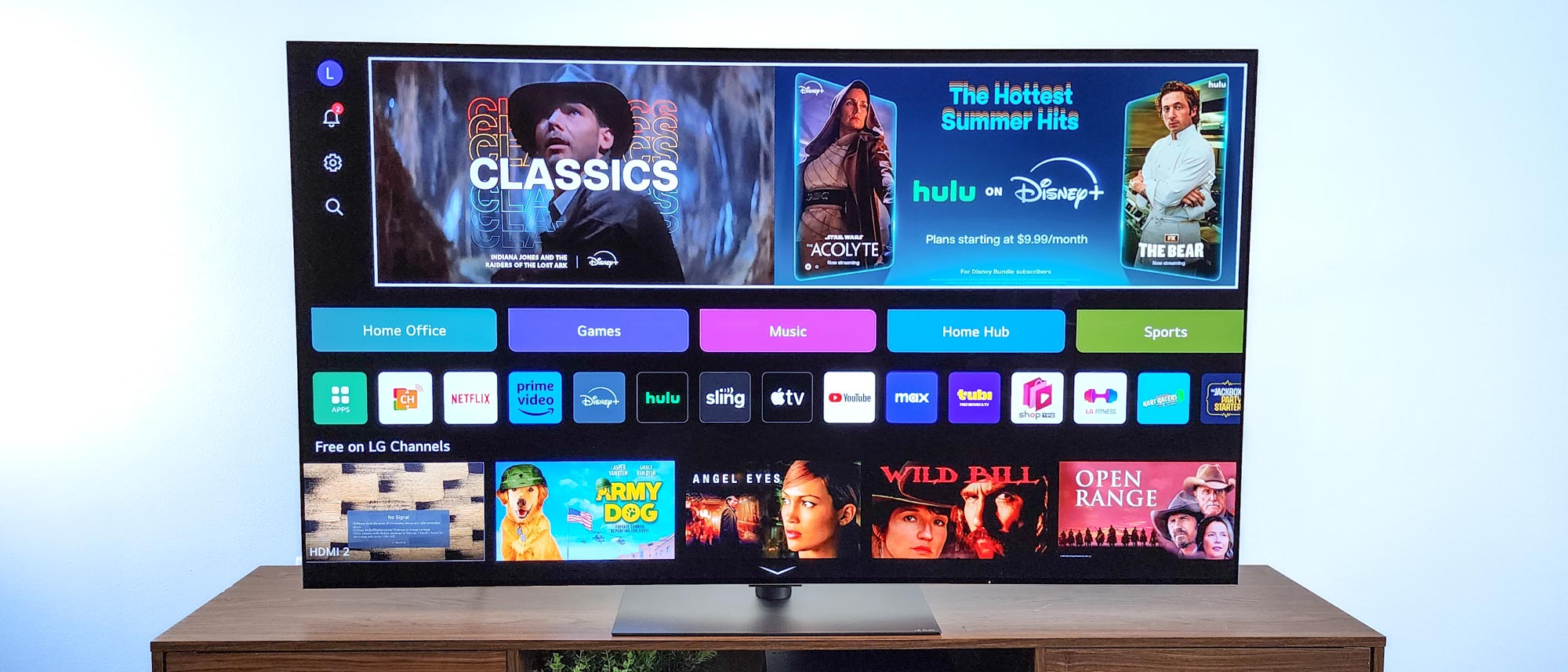Tom's Guide Verdict
With a superb picture, gaming capabilities, and operating system, and plenty of other forward-looking features, the LG G4 is an OLED TV that gets just about everything right.
Pros
- +
Outstanding picture quality
- +
Smart interface
- +
Strong gaming features
- +
Four HDMI 2.1 ports
Cons
- -
Average sound
- -
No ATSC 3.0 tuner, HDR10+ support
Why you can trust Tom's Guide
Price: $3,399.99 ($2,999.99 on sale)
Screen size: 65 inches
Model: OLED65G4SUB
Resolution: 3,840x2,160
HDR: HDR10, HLG, Dolby Vision
Refresh Rate: 120Hz
Ports: 4 HDMI 2.1, 3 USB
Audio: 60W
Smart TV Software: webOS 24
Size (without stand): 56.7x32.5x1.0 inches
Weight (without stand): 52.5 pounds
When you’re discussing the best OLED TV you can buy, LG is always prominent in the conversation — and its new flagship model, the LG G4 OLED, is a prime example of why. It builds on the cunning advancements and top-level performance of last year’s LG G3 OLED while also managing to be even better looking, easier to use and better suited for all watching environments. It’s expensive, yes (with the 65-inch model priced around $3,000), but you’ll see your investment in everything the G4 displays and does.
Our testing showed excellent color and brightness with both SDR and HDR content, and LG’s gaming-centered additions remain top-notch. It’s possible to nitpick: There’s no ATSC 3.0 tuner, and at least one competing set just barely edges it out as the OLED picture champ. But these things won’t much diminish your experience watching the G4, which is satisfying in every way, with every type of show or movie.
If you have the means, this is one of the best TVs money can buy.
LG G4 review: Pricing and availability
The G4 sits at the top of LG’s OLED catalog, offering a more sophisticated picture and groundbreaking technologies than (in descending order) the LG C4 OLED and B4 TVs. (The recently announced M4 is almost identical except for its wireless design.) The G4 comes in five different sizes, all of which are available as of this writing:
- LG OLED55G4SUB (55-inch): $2,599.99 | Sale: $2,229.99
- LG OLED65G4SUB (65-inch): $3,399.99 | Sale: $2,999.99
- LG OLED77G4WUA (77-inch): $4599.99 | Sale: $4,299.99
- LG OLED83G4WUA (83-inch): $6,499.99 | Sale: $6,299.99
- LG OLED97G4WUA (97-inch): $24,999.99
We evaluated the 65-inch G4, though because the 55-, 77-, and 83-inch versions all use identical technology, we expect them to deliver similar performance. The 97-inch model is the same as the others in all ways but one: It does not use LG’s Micro Lens Array, so its picture is likely to appear somewhat dimmer.
LG G4 review: Design
In many ways, the G4 is not your typical OLED TV. Whereas most have pure-glass screens measuring one-quarter inch or less, LG has amped up the G4’s thickness, so it comes in at just over half an inch, and a silver band along the edges gives it an unusually elegant, sparkling look. Shockingly, none of this makes it look bloated or bulky, and it increases stability while decreasing potential safety issues frequently associated with OLED sets. But as it measures 56.7x32.5 inches and weighs 52.5 pounds, it’s still a big set, and one you’ll want help setting up.
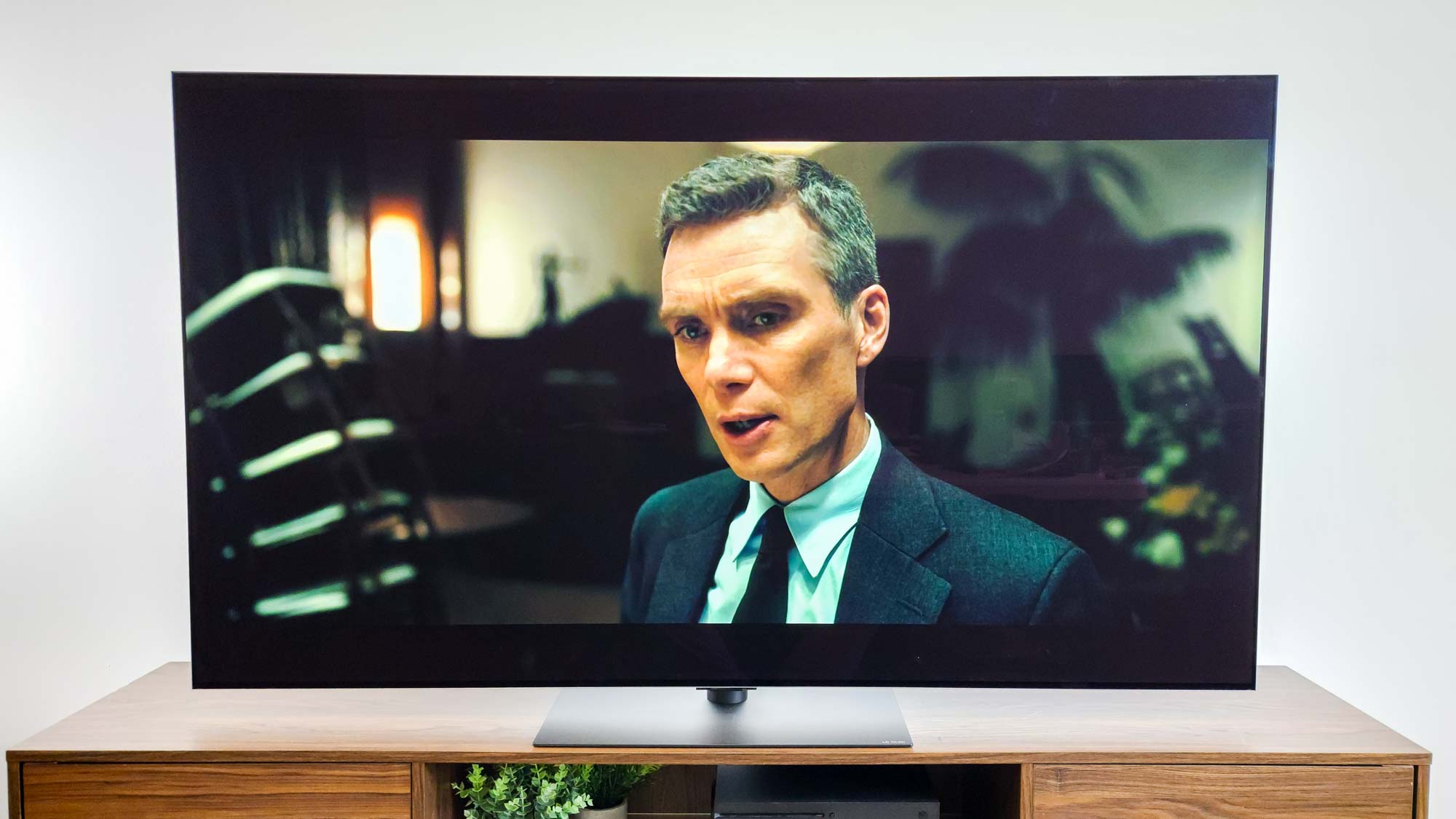
The G3 notoriously did not come bundled with a stand (and buying one separately was a supreme pain), but that’s a mistake LG has corrected with the G4. Not only is a stand included, but it takes just a few minutes to assemble. The stand can be configured to one of two heights (so the screen is either close to the surface it’s on, or so there’s room for a soundbar beneath); the wide panel-shaped foot extends both forward and backward for maximum stability; and the shaft that connects it to the TV has a built-in cable management channel. It’s all you could ask for.
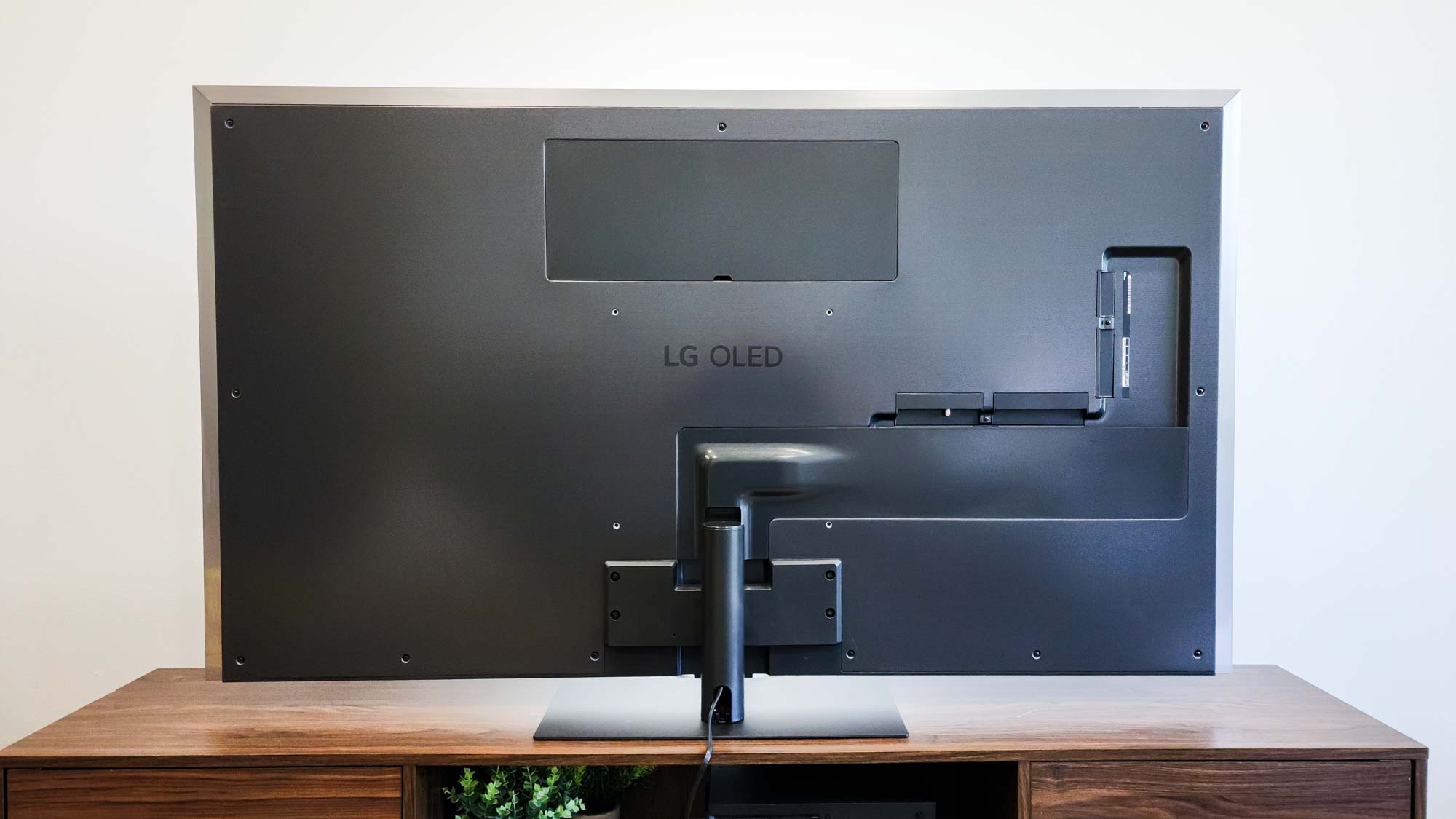
If you’d rather mount it on the wall, on the rear panel you can find traditional-style 300 x 200 VESA holes but LG’s proprietary system allows for nearly no gap between the set and the wall.
LG G4 review: Ports
Although the power cable on the back of the G4 is center mounted, the ports are all located closer to the TV’s left side. Three of these are particularly easily accessible: One USB port and two HDMI ports angle directly off the side so you can plug or unplug devices in seconds. For things you’re more likely to leave plugged in all the time, there is a selection of other ports facing downward just a few inches away: two USB, two HDMI, Ethernet, S/PDIF optical audio out, coaxial cable, RS-232C, and IR blaster.
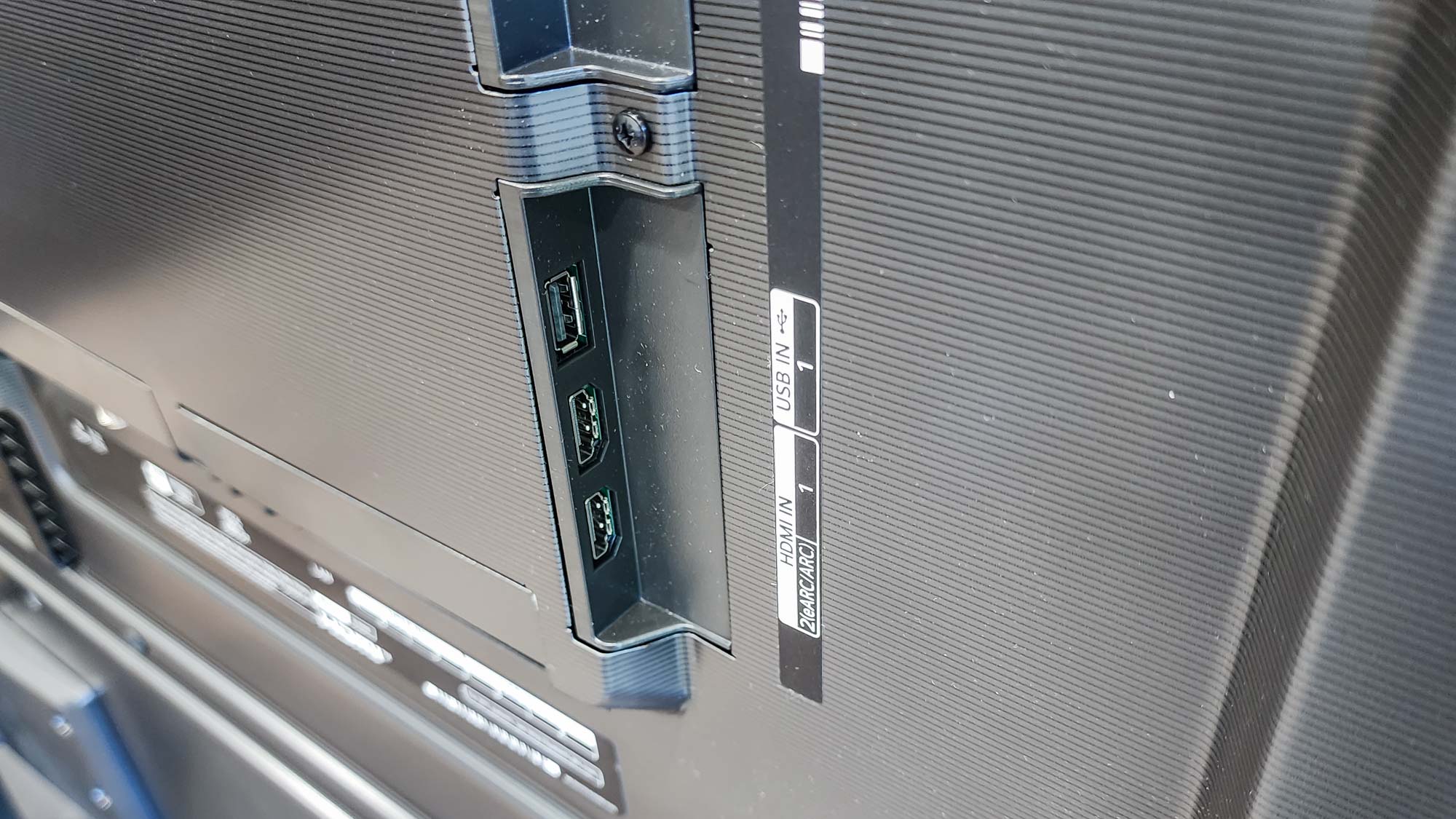
Per LG’s usual, all four HDMI ports use the newer and more powerful HDMI 2.1 standard that allows for features such as 4K video at 120Hz, Variable Refresh Rate (VRR), Auto Low-Latency Mode (ALLM), and Quick Media Switching (QMS). Not all manufacturers max out their TVs with this technology — we’re looking at you, Sony — so it’s nice to see LG giving its customers an extra dose of future-proofing on its highest-end set.
LG G4 review: How we test
We follow a standard testing protocol for every TV we review at Tom’s Guide. Our benchmarks include a series of technical and subjective tests designed to rate the set’s performance. For our technical tests, we take measurements using an X-Rite i1 Pro spectrophotometer, a SpectraCal VideoForge Pro pattern generator, and Portrait Displays’ Calman TV-calibration software. We also use a Leo Bodnar 4K Input Lag Tester for determining the TV’s gaming prowess.
Subjective tests vary based on the reviewer, but usually feature observations based on a diverse selection of movies, TV shows, and other content reflecting the things you may actually want to watch on the TV. For a more detailed look at what we do and how we do it, check out our How we test TVs page.
LG G4 review: Performance
OLED TVs tend to dazzle under most circumstances, but LG touts a whole catalogue of technologies in promoting the G4’s specific picture quality. These include the α11 AI Processor 4K that drives everything (and utilizes a number of AI-powered technologies to improve upscaling and tone) to Micro Lens Array (which LG claims “magnifies the glow of each pixel”) and Brightness Booster Max, which, uh, boosts the brightness. There’s support for three of the main formats of HDR: HDR10, Dolby Vision, and Hybrid Log Gamma (HLG), but not HDR10+. Ultimately, however, all that matters is what appears on the screen. And everything that appears on the G4’s screen looks remarkable.
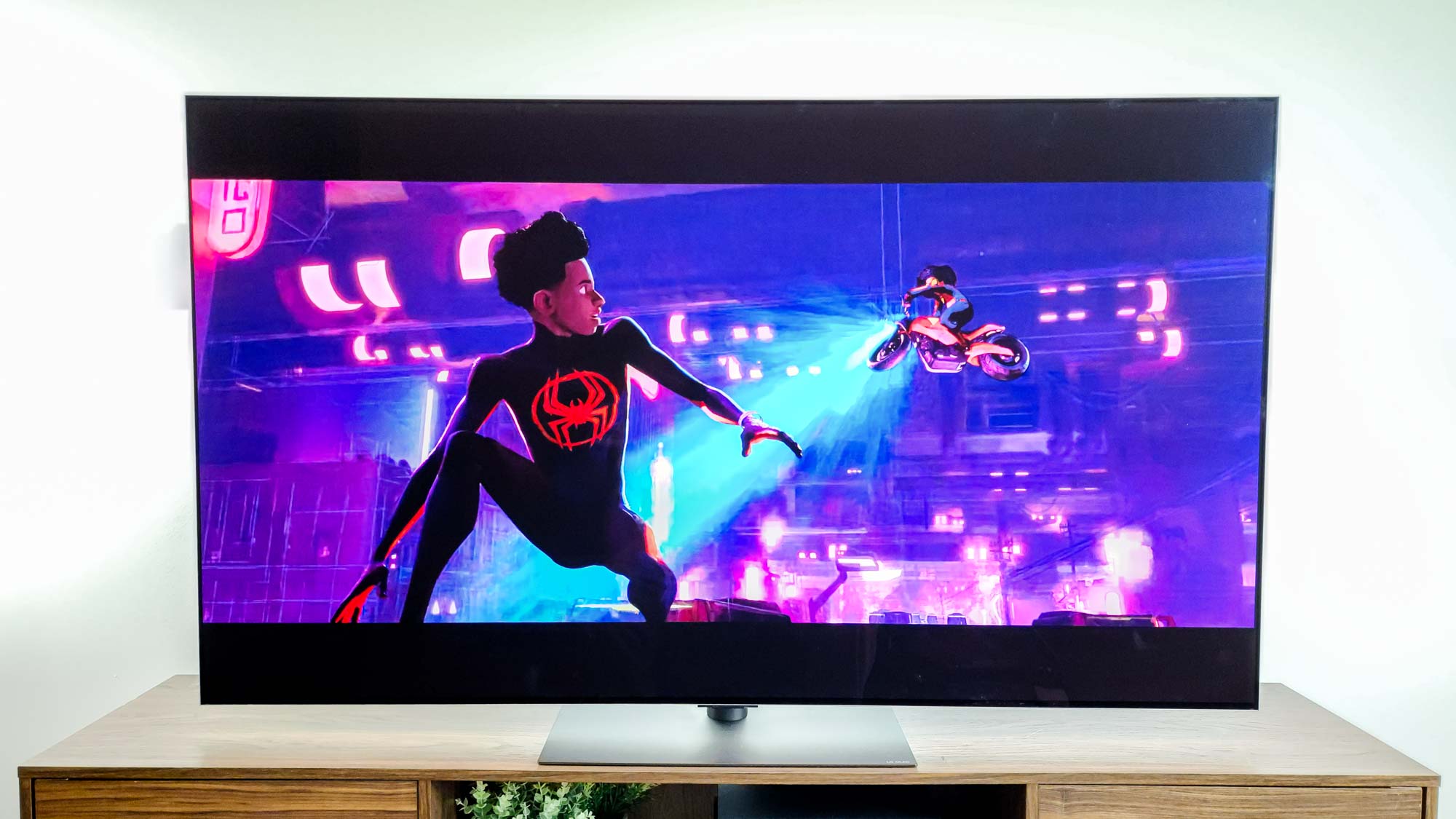
As on all OLEDs, black levels are perfect, but it’s that supercharged brightness that makes a critical difference in the G4’s overall impact. It gives an explosive boost to the central detonation scene in Oppenheimer, with searing brights cutting through the early-morning gloom to incisively highlight the world-changing nature of the first atomic bomb test. It also firmly emphasizes the comic-book contrasts inherent in the distinctive art style for Spider-Man: Across the Spider-Verse and the shadowy divisions between screen elements that heighten the action and the tension of Mission: Impossible—Dead Reckoning.
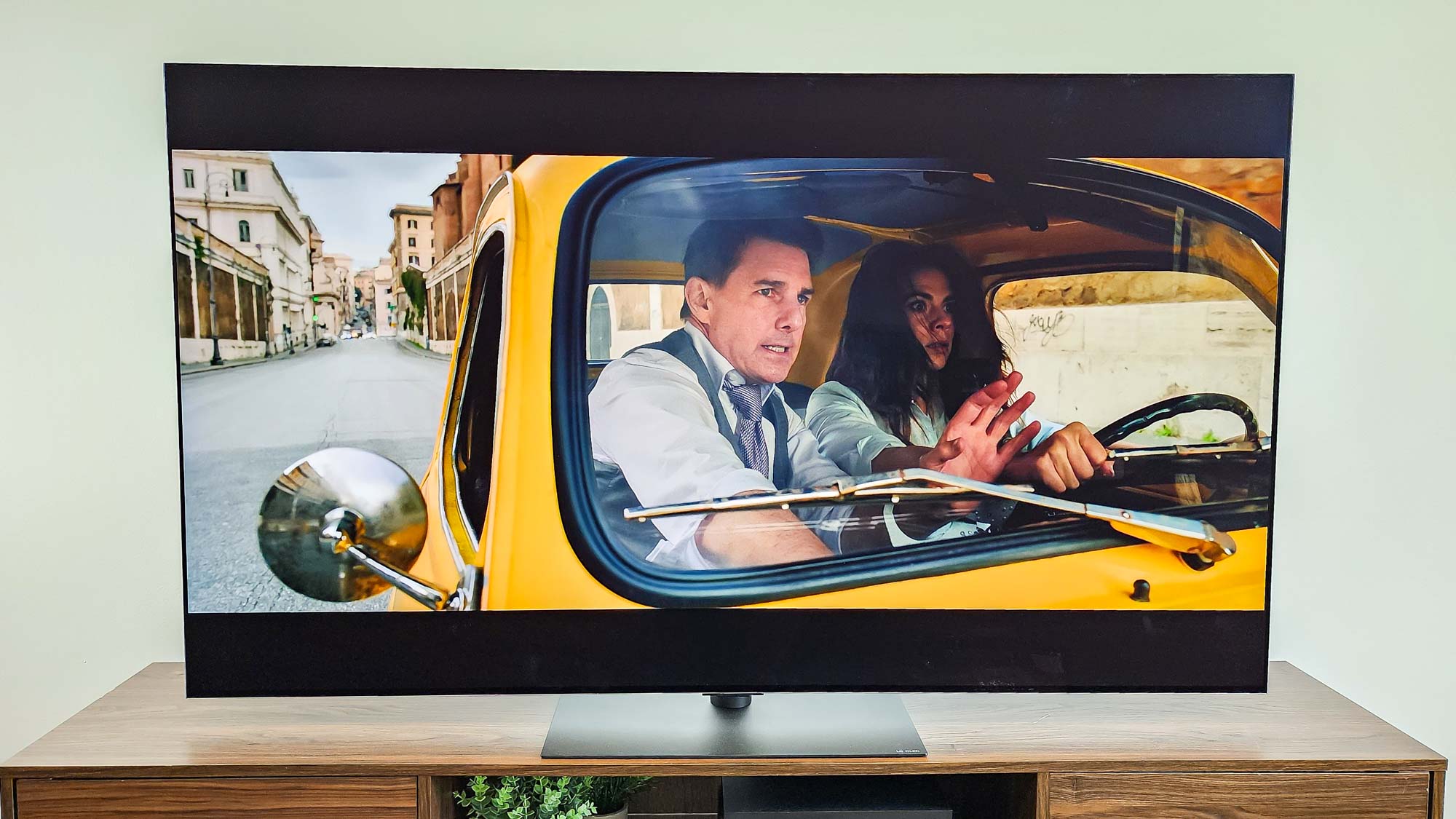
But the color is unimpeachable as well, in these titles as well as others where it’s even more important. You’re transported right to the underwater vistas of Pandora in Avatar: The Way of Water, with the sumptuous blues and greens of its flora and fauna mixing seamlessly with the fast motion of its more suspenseful chase scenes. Barbie looked equally good in the gaudy, pink-saturated Technicolor sections as it did in the scenes set in something more closely approaching the real world. And The Super Mario Bros. Movie looks about as good as it ever has, with its swirling animated cartoon palette as vibrant and humorous as the movie itself.
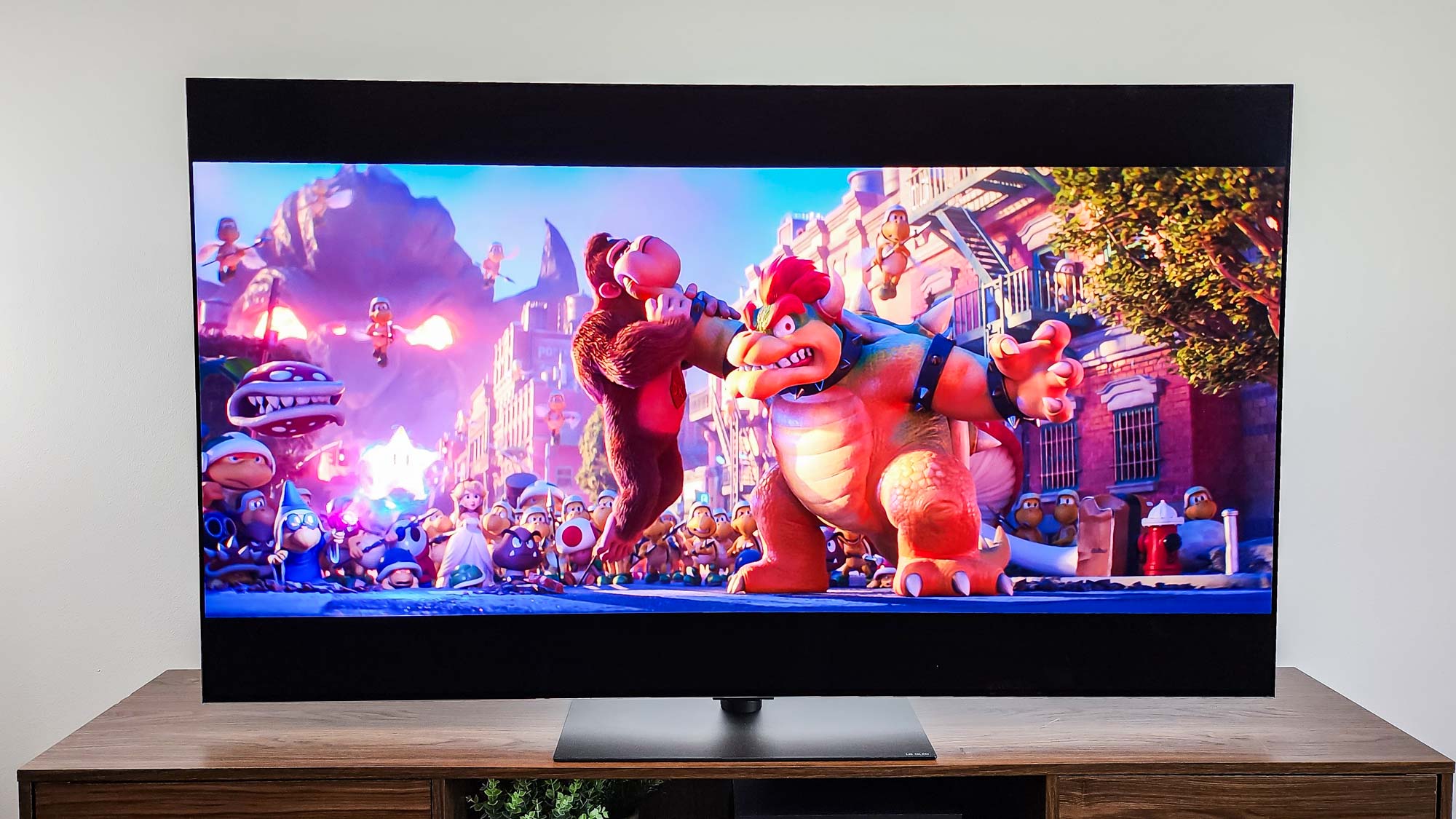
No matter what I watched, the G4’s picture impressed from any and every viewing angle, too, with its colors losing none of their luster. This is exactly what you want from a TV big enough (and expensive enough) to be the centerpiece of your living room entertainment setup.
LG G4 review: Test results
Our anecdotal experiences with the G4 were borne out by our technical tests, in which the TV also excelled. Against its primary competitor released so far this generation, the Samsung S95D, the G4 came out on top in our tests with SDR content, bettering the Samsung set in both brightness (358 versus 276 nits) and color accuracy (with Delta-Es, which measure the difference in color between the source and the screen, with lower numbers preferable, of 1.4041 and 3.5085 respectively).
The race was a bit closer with regards to HDR content, where the G4’s 1,488 nits (in Filmmaker Mode, measured on 10% of the screen) didn’t quite live up to the Samsung’s 1,777. It’s important to note, though, that as humans perceive brightness logarithmically, these differences are less likely to be detectable.
| Row 0 - Cell 0 | LG G4 | LG G3 | Samsung S95D | Sony A80L |
| SDR Brightness (10%, in nits) | 358 | 326 | 276 | 224 |
| Delta-E (lower is better) | 1.4041 | 1.8611 | 3.5085 | 3.3797 |
| Rec. 709 Gamut Coverage | 98.5546 | 99.7631 | 99.8042 | 109.529 |
| HDR Brightness (10%, in nits) | 1488 | 1361 | 1777 | 676 |
| UHDA-P3 Gamut Coverage | 97.17 | 96.73 | 99.97 | 99.08 |
| Rec. 2020 Gamut Coverage | 72.91 | 72.49 | 89.73 | 73.27 |
| Input Lag (ms) | 12.9/9.2 | 12.9/9.2 | 9.2 | 16.3 |
What may notice, though, is the G4’s HDR color handling, which falls more noticeably short of Samsung’s. The G4 covers a nearly perfect 97.29% of the UHDA-P3 color gamut, but the Samsung comes even closer with 99.97%. Because far less content takes advantage of the Rec. 2020 color space, numbers there don’t mean as much for everyday watching, but the G4’s 72.91% of coverage doesn’t come anywhere close to the Samsung’s 89.73%.
In short, under most circumstances you won’t notice anything wrong with the G4’s picture, but it’s not quite the best you can currently get.
LG G4 review: Audio
Not all TVs sound weak, but few sound great—even at the top end of the price range. The G4 does not make any drastic improvements in this area, though to my ears, it sounds marginally better than the G3: ever so slightly louder and just a mite clearer, but nothing that’s likely to convert diehard audiophiles. There’s not a heavy bass presence, with our test track, The Knife’s “Silent Shout,” thumping one-dimensionally, and a soprano vocal track did clip out just a bit with the set tuned to topmost volume.
For ordinary, everyday use, the G4’s sound is serviceable, and we had no substantive complaints to make when watching action scenes in movies such as Mission: Impossible—Dead Reckoning and Avatar: The Way of Water. But if you want to make your movies and music sound as good as possible, and if you have the additional money, you will probably want to supplement the G4 with one of Tom’s Guide’s best soundbars.
LG G4 review: Gaming
Given the G4’s high picture quality, it’s no surprise that gaming on it is a joy — I found myself lost in the galaxy-hopping wonders of Starfield all over again during testing, with a variety of alien planets, space battle scenes, and the human settlement of New Atlantis all a rich joy to explore.
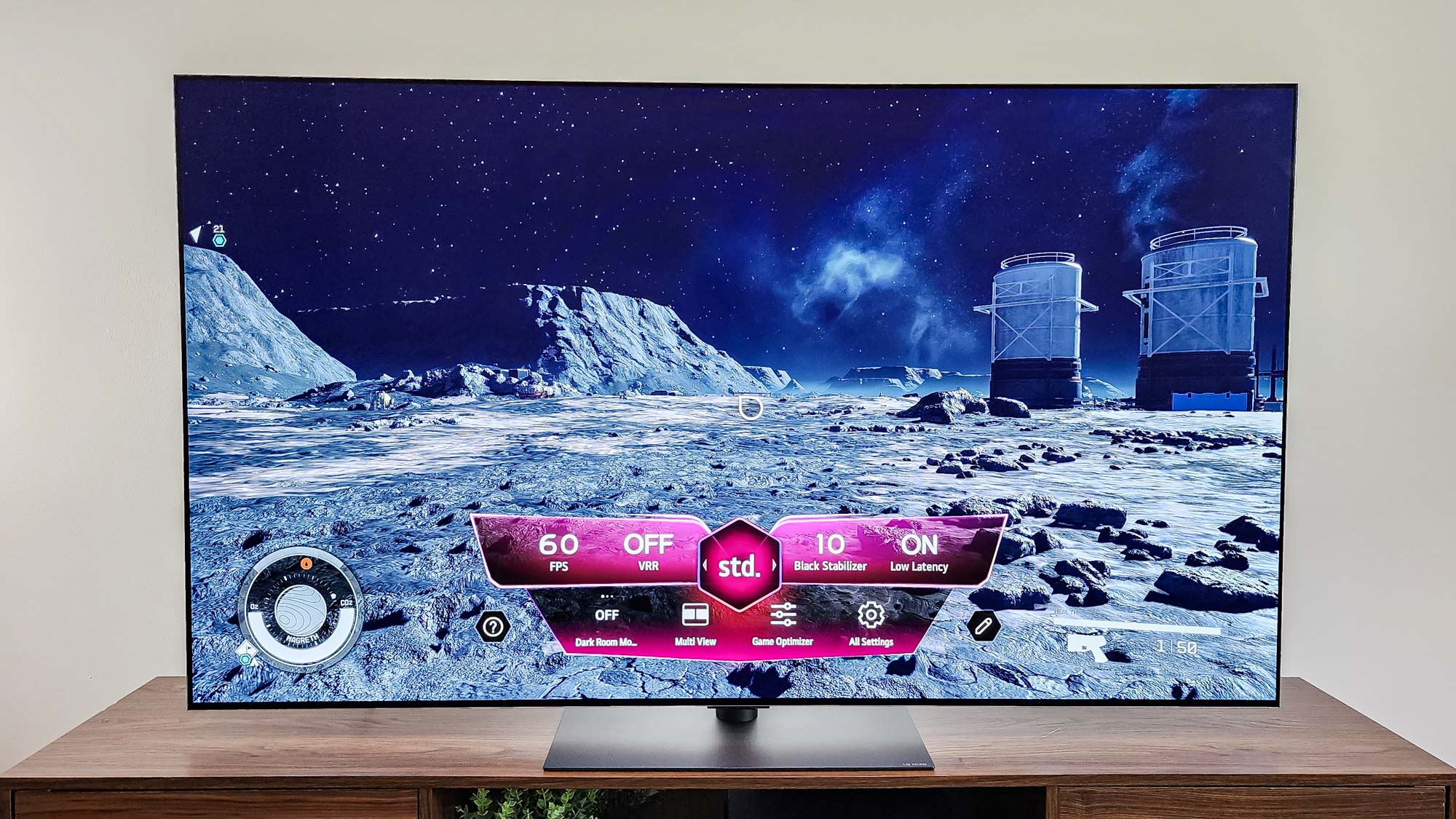
LG’s polished gaming features come by way of the integrated Game Optimizer, which you can turn on via the menus. These allow for lots of ways to customize your play for specific genres and even room environments, and a pop-up game bar gives you a ton of useful information such as the current frame rate, VRR status, and a quick way to turn on Dark Room Mode or Multi View, or change the settings. The panel’s high refresh rate keeps everything looking slick, but you have the potential to go even further: Although the HDMI ports max out at 120Hz for consoles like the Xbox Series X and the PlayStation 5, their refresh rates can register as high as 144Hz if you plug in a PC with a compatible graphics card.
Low input lag helps a lot, too. We measured a cool 9.2ms with the Game Optimizer Boost feature on — handily below our 10ms threshold for the smoothest gaming experience. (Without the boost function activated, we measured 12.9, which is still pretty good.)
LG G4 review: Smart features
LG has stuck with its proprietary webOS operating system, and I don’t mind at all. Even though lacks the ultrabroad integration of Google TV, it is tightly designed and a cinch to navigate and configure. The newest version, included with the G4, adds up to 10 user profiles and simplifies exploring the settings.
Below an expansive ad carousel at the top of the home screen is a row of Quick Cards that collect the G4’s functions into instantly recognizable categories (Home Office, Games, Music, Home Hub, Sports, and Accessibility). This is followed by an Apps bar that is prepopulated with all of the current most popular streaming services, though you can add more in seconds. Additional content, such as from LG Channels (the company’s own live-broadcast aggregation service) is called out below this. LG’s voice search system works well, but if you still can’t find something to watch, you can stream via Chromecast or Apple AirPlay 2.
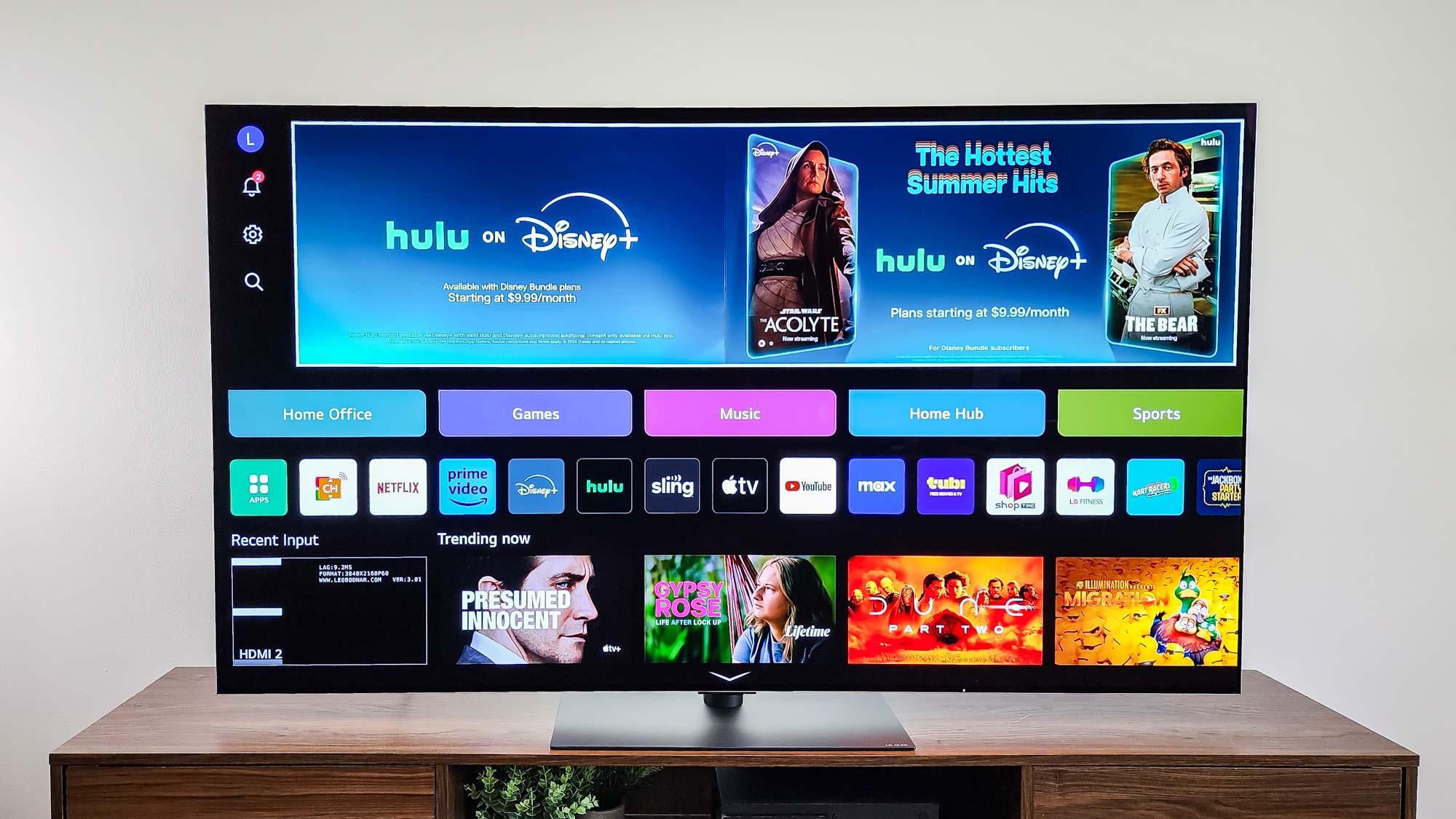
One thing you can’t get are over-the-air 4K broadcasts, as LG has done away with the ATSC 3.0 tuner in this generation due to a patent dispute; an ATSC 1.0 tuner is installed instead. This is a notable omission and something you don’t want to see on a top-of-the-line TV.
Support for Amazon Alexa, Apple Airplay 2, Apple Home, and Google Assistant further expands the G4’s capabilities into the smart home realm. You can also set the TV to display photos or other artwork when you’re not watching it, which is a fun way to bring more color to your living room.
LG G4 review: Remote
The Magic Remote remains LG’s control of choice for the G4. The ergonomic, black-plastic remote remains a bit old-fashioned in its inclusion of number buttons, but it has all the controls you need and a comfortable design that leaves very little to complain about.
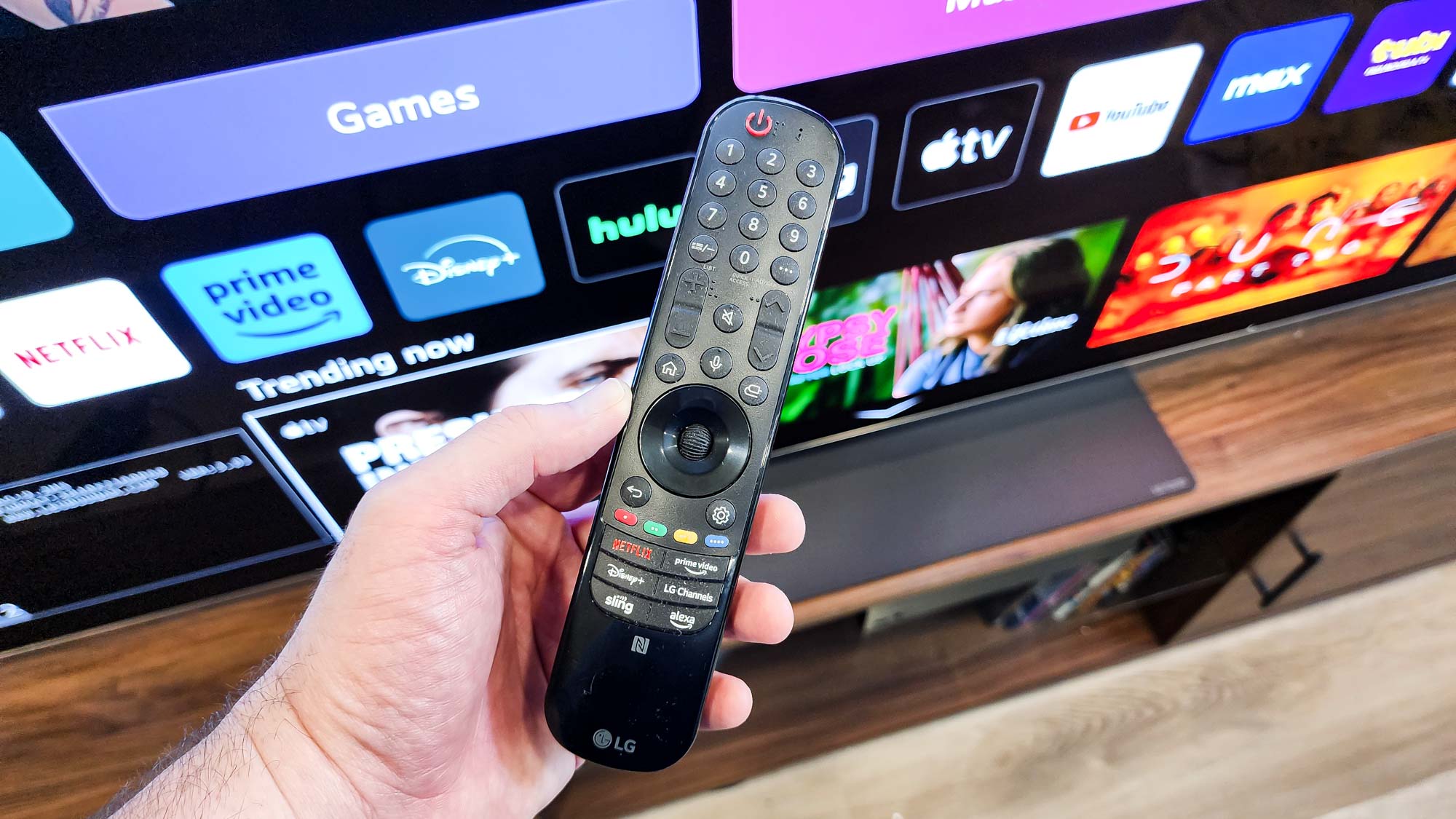
Its most controversial feature (to me, anyway) is what gives it its name: You can wave it around to display a mouse-style pointer, which you can then use to select on-screen elements. I still consider this more trouble than it’s worth, and I prefer using the five-way selection pad to move around the screen, but for people who like it, the option is there. And the rest of the remote is good enough that I have no problem overlooking it.
LG G4 review: Verdict
The LG G4 is a first-rate TV that makes anything you watch look better. Bursting with beautifully executed features that enhance picture quality, gaming, the OS and more, it’s a killer OLED that has little trouble earning its admittedly high price.
The same-priced Samsung S95D is a strong competitor, however, and its superior HDR handling may make it the front-runner if that’s what you care about most. Also in the running is last year’s LG G3 OLED, though only slightly less a compelling performer than the G4, it’s currently available for about $700 less (though, of course, this won’t always be the case).
But when you factor in everything — the gorgeous design, the sleekly effective webOS, and the do-everything remote control — the LG G4 leaves you wanting for basically nothing. If you’re looking for an OLED TV, it’s tough to do better than this.
Matthew Murray is the head of testing for Future, coordinating and conducting product testing at Tom’s Guide and other Future publications. He has previously covered technology and performance arts for multiple publications, edited numerous books, and worked as a theatre critic for more than 16 years.
